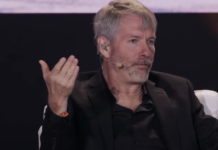
Lex Sokolin is betting big on the Fourth Industrial Revolution, or rather, how all the heady new technologies of today will shape tomorrow.
“We need new words,” he told Decrypt in an interview. “I’ve spent the last four years at ConsenSys in a couple of different roles, first in fintech and then on marketing and then on the crypto economics team.”
After his role as co-head of ConsenSys’ global fintech arm, Sokolin is now turning his attention to the integration of AI, crypto, and the so-called machine economy as a general partner at Generative Ventures.
The machine economy refers to the mesh network of various smart devices like phones and watches that make up the broader Internet of Things (IoT) sector. In the future, these devices, thanks to AI and crypto, will become operating autonomously, making payments with one another without any human intervention–at least that’s the thesis.
“I came into the space thinking a lot about fintech and financial services and that crypto and blockchain are the new architecture for financial services,” he said. “We’ve heard this now a million times, and I think it’s in many ways true.”
Still, the technologies underpinning Web3, Sokolin argues, can’t be the only enabler of economic activity.
When all activities are centered entirely on financial services, “we get Terra Luna, we get crazy professionals, we get lots of derivatives and we’re missing the economic activity.”
Economic activity still needs businesses inputting labor and exporting products and services to meet real-world demands.
“Only after you have the economy do you get finance to save, to pay, to bank to lend. All of that is there to service the actual economic output,” said Sokolin. “Then DeFi, NFTs, digital objects and markets, all of that just comes there to support the beautiful and interesting things that people make.”
Accelerating that native economy is now at the heart of Sokolin’s thesis.
He also sees AI, specifically generative AI, as another core tenet of this yet-to-exist future.
“Generative AI is a way for people to augment their labor to be more productive, to be more creative, and especially to work where people have thin attention spans, or they’re contributing some but not everything. They’re not full-time,” says Sokolin. “Generative AI is a way for them to amplify their labor to make things at a much bigger scale.”
Thus, despite calls for improved trading experience or wallet accessibility, crypto’s builders should instead turn their attention to the software sector to create those AI-powered economic rails.
From custodial to non-custodial information
Identity and ownership are another rich problem space where Sokolin says blockchain and AI can lead to serious improvements.
“I don’t know if the [right] word is urgency, but if AI is left in the big tech firms, you’re going to have Web2 to the extremes where content is infinite, dopamine addiction is infinite, everything is free, and people are the product,” he said. “It’s the same as with social media, just on steroids. That’s why the solutions that Web3 offered to data privacy are more important than ever before.”
He believes that just as custodial finance evolved into non-custodial finance, a similar transition is needed in the realm of information—from custodial information to non-custodial information.
Critically, Web3 architecture will play a key role in this transition.
“I would want an avatar as a digital object and NFT that I own. If it has software it can call, if it can touch my money, if it can have permissions, all of that needs to be in an economic architecture,” said Sokolin. “The other angle around the machine economy is that if I’m going to have AI agents, I need to have ownership control.”
But again, he added, “if we end up picking the word machine economy, all these activities are only meaningful when they’re producing some value and all that stuff settles on blockchain networks.”
To date, Generative Ventures has already invested in two projects and seeks to add more companies to its portfolio, focusing on leading Seed and Series A rounds.
“There’s Taiko, a zkEVM Layer-2 project, which is one of the leaders in terms of users and transactions, and another one is called AegisWeb3, which protects people when they interact with different things on Web3, by telling them what their transactions are going to do before they do them,” Sokolin told Decrypt.
Other ideas the fund is looking into are aggregators of open-source models, as well as putting zero-knowledge proofs into outputs from machine learning models.
“There are some projects that are working on using ZK proofs, like authenticating the veracity of the information and linking it all the way through and giving you the version of the model that generated the information like the underlying source, whether it’s true or not,” said Sokolin.
According to him, it’s still early days, but people are starting to play at the edge and we are seeing “a lot of overlap between the two technologies.”








